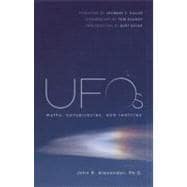
Dr. John B. Alexander, a Green Beret combat veteran, was a colonel when he retired from the U.S. Army; a project manager at Los Alamos National Laboratory; a member of NATO, National Research Council, and Council on Foreign Relations, studies of non-lethal weapons; a consultant to the National Intelligence Council, CIA, US Special Operations Command, and the Army Science Board. He is widely published in several areas. Currently he is a senior fellow at a DoD university and lives with his wife, Victoria, in Las Vegas, Nevada.
| Acknowledgments | p. xiii |
| Foreword | p. xv |
| Commentary | p. xix |
| Introduction | p. xxi |
| Prologue | p. 1 |
| Advanced Theoretical Physics Project Disclosed | p. 6 |
| The Corso Conundrum | p. 40 |
| The Condon Report Revisited | p. 51 |
| The Congressional Hearings That Never Happened | p. 65 |
| The Government and UFOs | p. 75 |
| The Presidential Paradox | p. 101 |
| Majestic 12 | p. 122 |
| The Apollo Lunar Program | p. 134 |
| Reverse-engineering UFOs | p. 144 |
| Real Cases and Hard Data | p. 155 |
| The UK Connection | p. 183 |
| Sworn to Secrecy | p. 196 |
| What NATO Knows | p. 212 |
| Considerations, Speculation, and Puzzles Addressed | p. 222 |
| The Twilight Zone | p. 255 |
| Epilogue: Quo Vadis? | p. 269 |
| p. 275 | |
| p. 285 | |
| p. 287 | |
| p. 294 | |
| Index | p. 297 |
| Table of Contents provided by Ingram. All Rights Reserved. |
The New copy of this book will include any supplemental materials advertised. Please check the title of the book to determine if it should include any access cards, study guides, lab manuals, CDs, etc.
The Used, Rental and eBook copies of this book are not guaranteed to include any supplemental materials. Typically, only the book itself is included. This is true even if the title states it includes any access cards, study guides, lab manuals, CDs, etc.